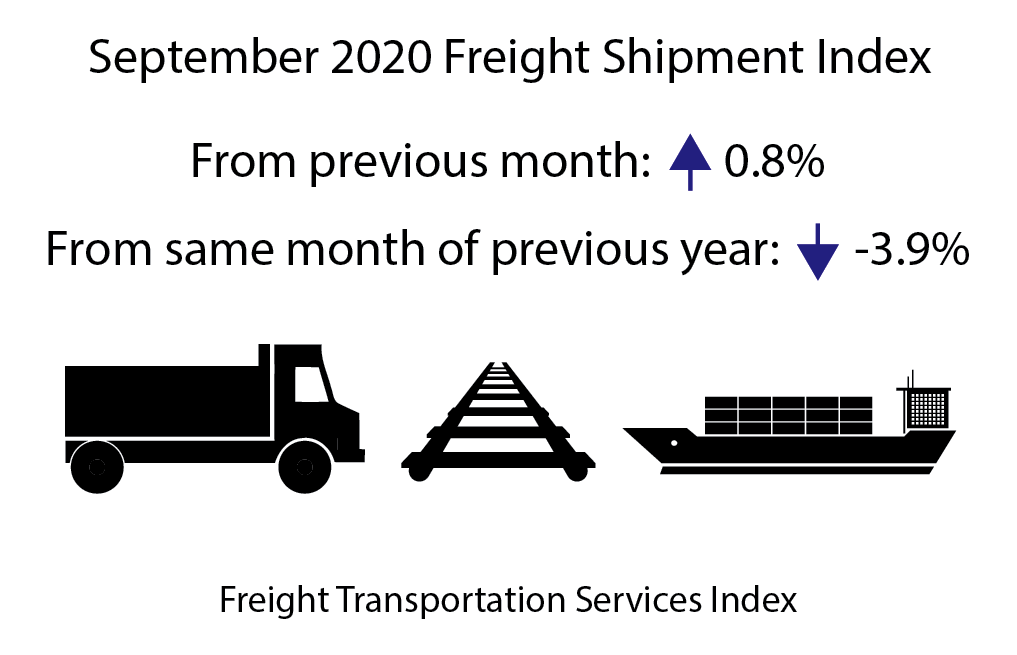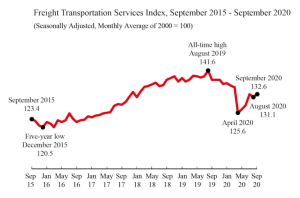
The Freight Transportation Services Index (TSI), which is based on the amount of freight carried by the for-hire transportation industry, rose 0.8% in September from August, rising after a one-month decline, according to the U.S. Department of Transportation’s Bureau of Transportation Statistics’ (BTS). From September 2019 to September 2020, the index fell 3.9% compared to a decline of 0.1% from September 2018 to September 2019 and a rise of 7.2% from September 2017 to September 2018 (Tables 1, 2, and 2A).

The level of for-hire freight shipments in September measured by the Freight TSI (132.6) was 6.4% below the all-time high level of 141.6 in August 2019 (Table 2A). BTS’ TSI records begin in 2000. See historical TSI data.
The August index was revised to 131.6 from 131.1 in last month’s release but still remains below the July 2020 level. Monthly numbers for January and February as well as June and July were revised down slightly. April was revised up slightly.
BTS is withholding the scheduled release of the passenger and combined indexes for September. The passenger index for September is a statistical estimate of airline passenger travel and other components based on historical trends up to August 2020. The statistical estimate does not fully account for the rapidly changing impacts of the coronavirus on the historical trend. Air freight for September is also a statistical estimate. Since air freight makes up a smaller part of the freight index, the freight TSI is being released as scheduled with the air freight estimate included. The August passenger and combined indexes are available on the BTS website.
The Freight TSI measures the month-to-month changes in for-hire freight shipments by mode of transportation in tons and ton-miles, which are combined into one index. The index measures the output of the for-hire freight transportation industry and consists of data from for-hire trucking, rail, inland waterways, pipelines and air freight. The TSI is seasonally-adjusted to remove regular seasons from month-to-month comparisons.
Analysis: The Freight TSI increased 0.8% in September from August due to growth in water, rail intermodal, rail carload, and air freight, despite declines in pipeline and trucking. The September increase took place against the background of mixed results in other indicators.
The Institute for Supply Management Manufacturing (ISM) index was down by 0.6 points to 55.4, indicating continued but decelerating growth in manufacturing. The Federal Reserve Board Industrial Production (IP) Index declined 1.3% in September reflecting decreases of 0.3% in manufacturing and 5.6% in utilities, while mining increased by 1.7% . Housing starts grew by 1.9%. Personal Income was up 0.9%.
Although the September Passenger TSI is being withheld because of the difficulty of estimating air passenger miles and other modes, the August index is now being released. The index rose 37.9% from July to August, the fourth consecutive increase following three months of decline, which left it below any level the Passenger TSI had been before the pandemic for the sixth consecutive month. Air passenger, rail passenger and transit were all up in August.
Trend: The September increase in the Freight index reversed the August decrease, returning TSI to the July level of 132.6. The index has declined in four of the nine months of 2020, for a total decrease of 2.9% in 2020. During those months, the index dropped from a high of 136.8 in January to a low of 125.7 in April and back to the current 132.6. Compared to pre-pandemic levels, the index is at a level comparable to January 2018 when it was 131.6.
The index remained 2.4% below its pre-pandemic level in February, and 3.1% below its recent peak in January. However, it is 4.4% above its pandemic low point in April. It is now 6.4% below its all-time high in August 2019. The index was below the levels of every month from February 2018 to March 2020 for the sixth consecutive month. However, it was above every level before December 2017 when the index reached 133.5. For additional historical data, go to TSI data.
The third-quarter increase of 3.0% came in the context of the largest rise in quarterly Gross Domestic Product (GDP) on record (since 1947). The GDP increase reflected continued efforts to reopen businesses and resume activities that were postponed or restricted due to COVID-19, according to the Bureau of Economic Analysis. For additional historical data, go to TSI data.
Index highs and lows: For-hire freight shipments in September 2020 (132.6) were 39.7% higher than the low in April 2009 during the recession (94.9). The September 2020 level was 6.4% below the historic peak reached in August 2019 (141.6).
Year-to-date: For-hire freight shipments measured by the index were down 2.9% in September compared to the end of 2019 (Table 3).
Long-term trend: For-hire freight shipments are up 7.5% in the five years from September 2015 and are up 23.7% in the 10 years from September 2010 (Table 5).
Same month of previous year: September 2020 for-hire freight shipments were down 3.9% from September 2019 (Tables 4, 5).
3rd quarter changes: The freight TSI rose 3.0% in the third quarter, the first quarterly increase since the second quarter of 2019 after four consecutive quarterly declines (Table 6).
The TSI has three seasonally-adjusted indexes that measure changes from the monthly average of the base year of 2000. The three indexes are freight shipments, passenger travel and a combined measure that merges the freight and passenger indexes. See Seasonally-Adjusted Transportation Data for numbers for individual modes. TSI includes data from 2000 to the present. Release of the October 2020 index is scheduled for Dec. 9.
Revisions: Monthly data has changed from previous releases due to the use of concurrent seasonal analysis, which results in seasonal analysis factors changing as each month’s data are added.
BTS research has shown a clear relationship between economic cycles and the Freight and Passenger Transportation Services Indexes. See a study of this relationship using smoothed and detrended TSI data. Researchers who wish to compare TSI over time with other economic indicators, can use the FRED database, which includes freight, passenger and combined TSI, and which makes it possible to easily graph TSI alongside the other series in that database. See TSI data on FRED.
For charts and discussion on the relationship of the TSI to the economy, see Transportation as an Economic Indicator: Transportation Services Index.
A BTS report explaining the TSI, Transportation Services Index and the Economy, is available for download.
Table 1: Freight Transportation Services Index since March 2020
Percent Change from Previous Month
(Seasonally Adjusted, Monthly Average of 2000 = 100)
|
Freight |
|
|
|
| |
Index |
Pct. Change |
|
|
|
| |
March |
135.3 |
-0.5 |
|
|
|
|
April |
125.7 |
-7.1 |
|
|
|
|
May |
127.0 |
1.0 |
|
|
|
|
June |
128.7 |
1.3 |
|
|
|
|
July |
132.6 |
3.0 |
|
|
|
|
August |
131.6 |
-0.8 |
|
|
|
|
September |
132.6 |
0.8 |
|








